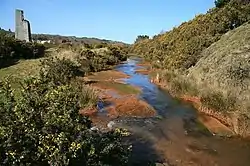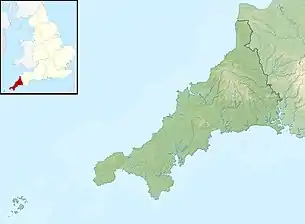Carnon River
The Carnon River is a heavily polluted river in Cornwall, England.[1] It starts in Chacewater.[2] Trewedna Water[3] and River Kennall[4] flow into the Carnon before it merges with Tallack's Creek to become Restronguet Creek,[5] which eventually flows into the English Channel at the mouth of Carrick Roads.[6]
| Carnon River | |
|---|---|
 Carnon River near Point Mills | |
 Location within Cornwall | |
| Location | |
| Country | England |
| County | Cornwall |
| Physical characteristics | |
| Source | |
| • location | Chacewater, Cornwall |
| • coordinates | 50°15′45″N 5°09′30″W |
| Mouth | Restronguet Creek |
• location | Cornwall |
• coordinates | 50°12′28″N 5°04′59″W |
| Basin features | |
| Tributaries | |
| • left | 50°12′51″N 5°05′55″W, 50°12′51″N 5°05′54″W, 50°12′51″N 5°05′54″W, 50°12′45″N 5°05′54″W, 50°12′20″N 5°05′02″W |
| • right | 50°14′14″N 5°08′31″W, 50°13′49″N 5°07′35″W, Trewenda Water 50°12′54″N 5°06′04″W, River Kennall 50°12′25″N 5°05′29″W, Tallack's Creek 50°12′38″N 5°04′59″W |
The Nebra sky disc, a gold-decorated bronze disc found in Germany and dated to the Bronze Age, contains both gold and tin from the Carnon valley.[7][8]
In 1992 the river was hit by a major pollution incident, when over 45 million litres of contaminated water from the closed Wheal Jane mine was released by the collapse of an adit, colouring the river water red. A treatment works has since been installed at Wheal Jane to intercept the contaminated water and treat it to remove suspended metals and restore a neutral pH.[9]
References
- "Case study:Carnon River: Abandoned Metal Mines". Restore. River Restoration Centre. Retrieved 29 January 2018.
- "Google Maps". Google Maps. Retrieved 30 January 2018.
- "Google Maps". Google Maps. Retrieved 30 January 2018.
- "Google Maps". Google Maps. Retrieved 30 January 2018.
- "Google Maps". Google Maps. Retrieved 30 January 2018.
- "Google Maps". Google Maps. Retrieved 30 January 2018.
- Ehser, Anja; Borg, Gregor; Pernicka, Ernst (2011). "Provenance of the gold of the Early Bronze Age Nebra Sky Disk, central Germany: geochemical characterization of natural gold from Cornwall". European Journal of Mineralogy. 23 (6): 895–910. doi:10.1127/0935-1221/2011/0023-2140. Retrieved 1 February 2018.
- Haustein, M. (2010). "TIN ISOTOPY-A NEW METHOD FOR SOLVING OLD QUESTIONS". Archaeometry. 52: 816–832. doi:10.1111/j.1475-4754.2010.00515.x.
- "Pumping the polluted water from mines - BBC News". BBC Online. Retrieved 1 February 2018.
External links
| Wikimedia Commons has media related to Carnon River. |
- "Upper Carnon River". Catchment Data Explorer. Environment Agency.
- "Lower River Carnon". Catchment Data Explorer. Environment Agency.